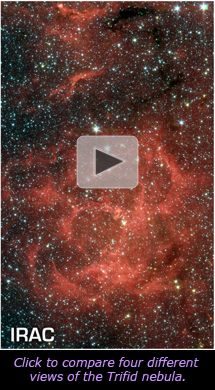
What about those colors?
The Spitzer instruments can see different parts of the infrared spectrum, in the same way that your eye can see different parts (red, green and blue) of the visible spectrum. We refer to the different parts of the spectrum by their wavelengths, which are measured in microns (millionths of a meter). The IRAC instrument used for the GLIMPSE survey sees four wavelengths at 3.6, 4.5, 5.8, and 8 microns. The MIPS instrument used for the MIPSGAL survey sees 24, and 70 microns.
But none of these wavelengths are visible to us, so scientists map them to visible colors to create images like these. The colors are chosen to highlight different physical processes (and yes, so they'll look nice too!) Here are few examples of what the colors can tell us.

